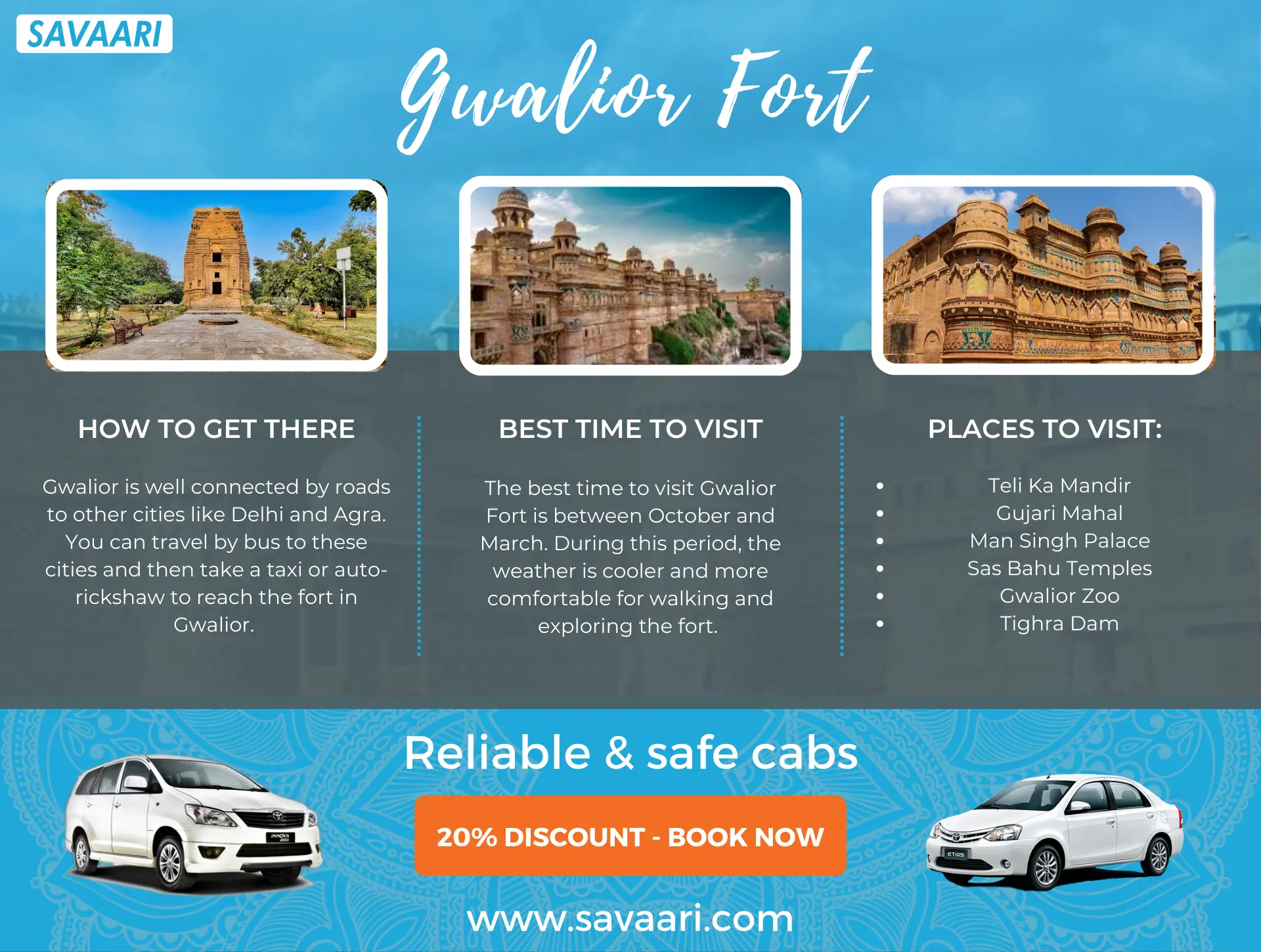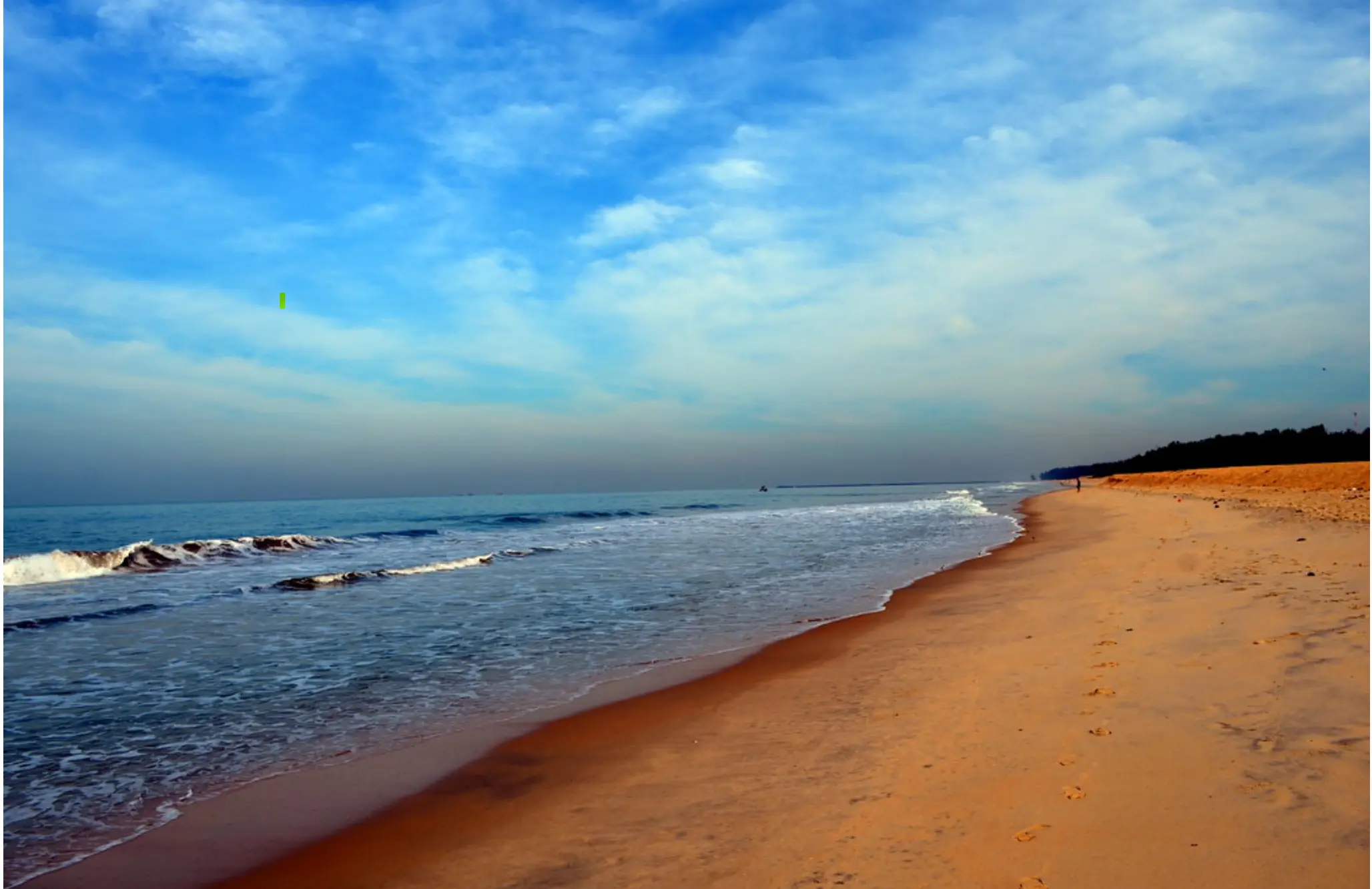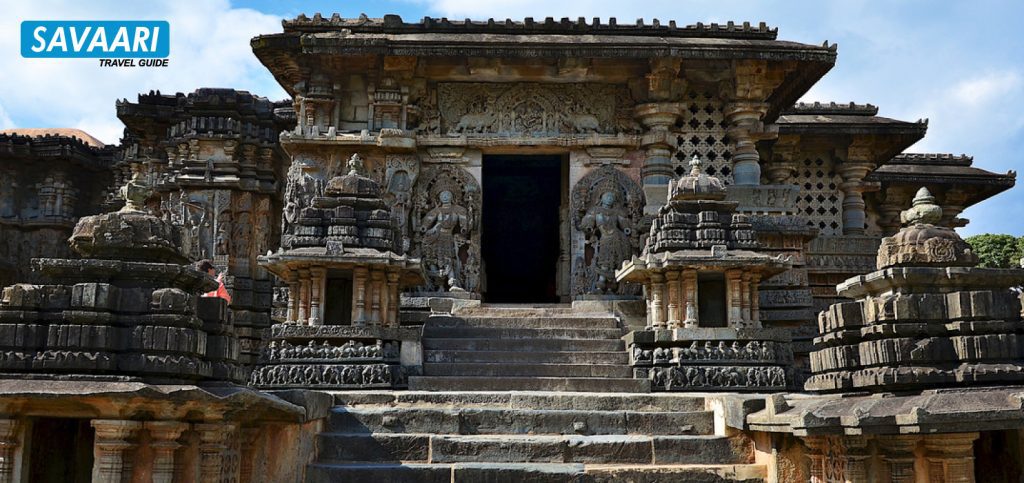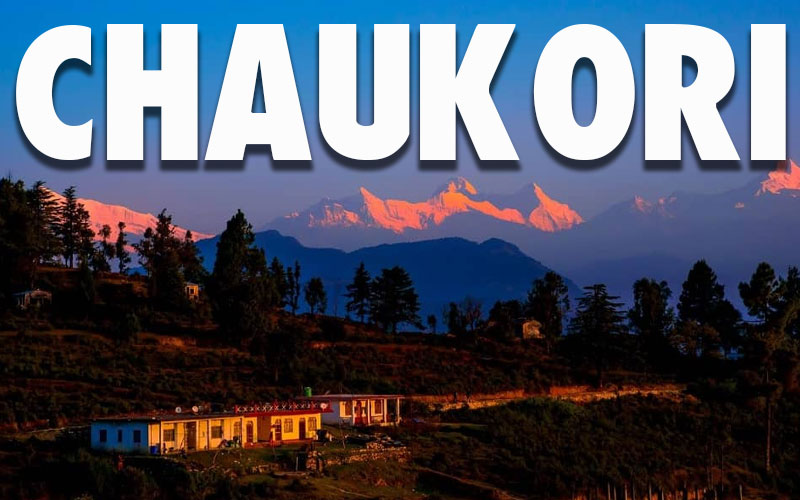Imagine standing atop a hill overlooking a city steeped in history, where every stone has a story to tell. The Gwalior Fort isn’t just a place you’ve seen in textbooks or online photos; it’s a living relic, an architectural marvel that has witnessed centuries of dynastic rule, from the Tomars and Mughals to the Marathas and Scindias.
If you’re a history enthusiast and crave a journey through time, the Gwalior Fort is a must-visit. There are so many things to do in Gwalior Fort—far more than you might expect. So get ready to uncover the secrets of this ancient citadel in this ultimate travel guide. Book a reliable car rental in Delhi with Savaari and head to the majestic fort in the company of your loved ones.
Table of Contents
- About Gwalior Fort
- Comprehensive Guide to Cover Gwalior Fort
- How to Plan a Trip to Gwalior Fort
- Resorts and Hotels Near Gwalior Fort
- Highest Road Trips from Gwalior
- Useful Links
About Gwalior Fort
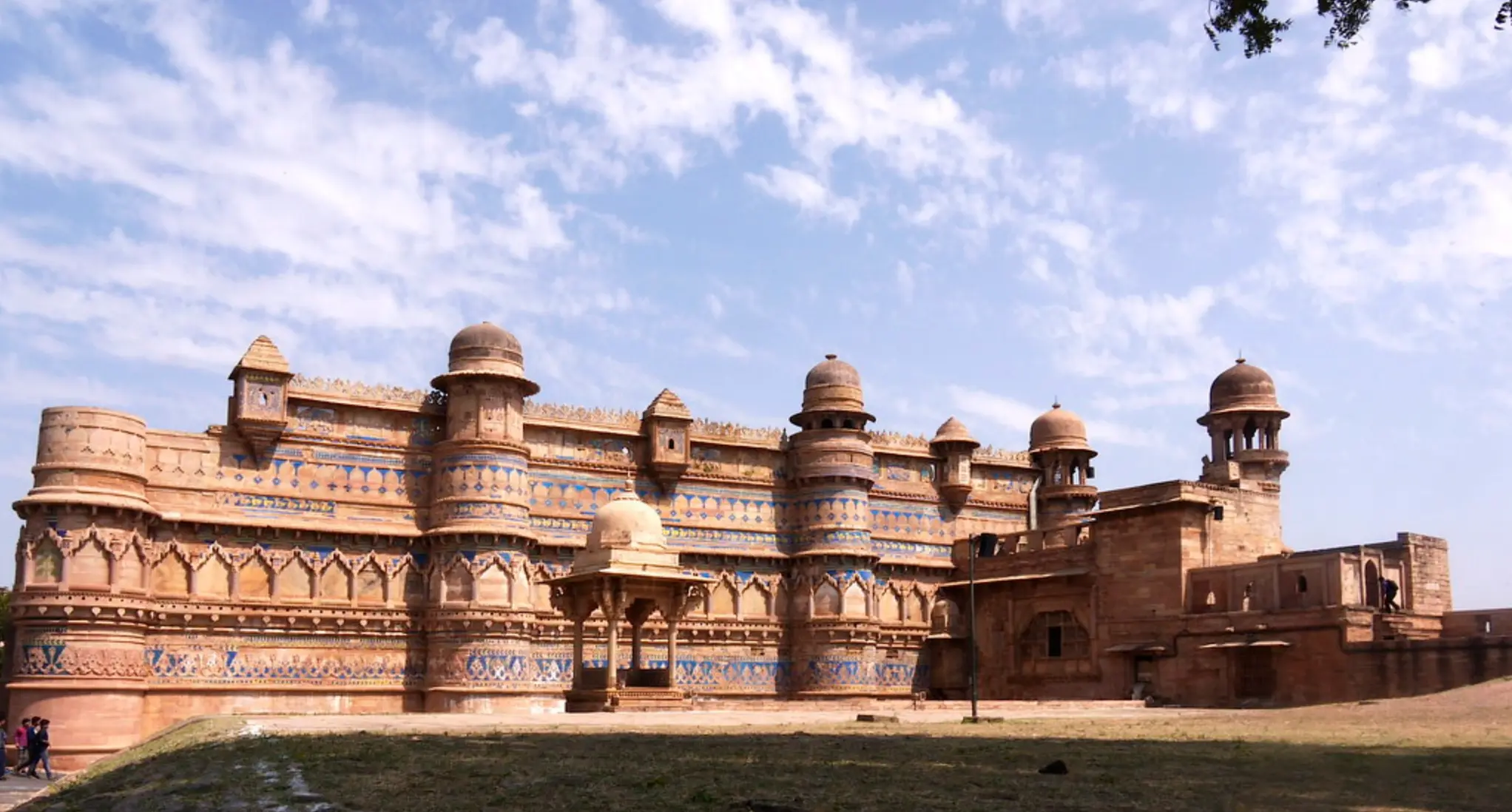
Located in the heart of the Indian state of Madhya Pradesh is the famed Gwalior Fort, also popularly called “the Gibraltar of India” because of its design and rich history. Over a thousand years old, this majestic fort covers an area of about three square kilometers and is almost three hundred feet high, offering a scenic view of the city and its surroundings.
History of Gwalior Fort
The history of Gwalior Fort dates back to the 8th century, when many powerful dynasties, including the Tomars, Mughals, Marathas, and Scindias, reigned. Mughal Emperor Babur once referred to it as “the pearl amongst fortresses in India” after his victory there.
During the British colonial era, Gwalior Fort played a key role in India’s fight for independence. It was here that Rani Lakshmibai, the Queen of Jhansi, famously fought during the Indian Rebellion of 1857.
Owing to its strategic position atop a steep sandstone hill, the fort had a sturdy defense system that was impenetrable by enemy forces. This made it a prized possession for any ruler aiming to control the region.
Architecture of Gwalior Fort
Gwalior Fort combines different styles like Hindu, Jain, and Islamic architecture. The fort stretches over 3 kilometers long and 35 meters wide, showing the advanced building techniques of its time. Inside the fort, you’ll find a fascinating mix of palaces, temples, and water reservoirs. There are seven big gates, each with thick wooden doors covered in iron spikes to protect against elephant attacks. The main gate, called the Hathi Pol (Elephant Gate), is especially impressive with its intricate decorations.
The fort’s walls are made of sandstone and are so thick and strong that they can even resist cannon fire. The fort also has hidden passages and tunnels, which were used as escape routes during battles. The fort had step wells and tanks to ensure water was always available. The layout, with its courtyards, arches, and decorative screens, reflects the builders’ incredible expertise in mathematics and design.
If you are a group of more than eight members planning a trip to Gwalior from major cities like New Delhi, you can also hire a tempo traveller in Delhi with Savaari and enjoy a group travel experience in a chauffeur-driven tempo.
Lesser Known Facts about Gwalior Fort
Here are some interesting facts about Gwalior Fort that highlight its historical significance and architectural design:
- The name “Gwalior” comes from a story about a sage named Gwalipa who cured the local ruler, Suraj Sen, of leprosy. To thank him, Suraj Sen built the fort and named the city after the sage.
- The Gujari Mahal, a beautiful structure within the fort, was built by Raja Man Singh for his queen, Mrignayani.
- The fort hosts a light and sound show that narrates the history of Gwalior. It was one of the first of its kind in the world, held in an open-air space.
- There are about 30 inscriptions on the fort’s walls that reference the Gupta and Tomar periods.
- The fort is said to have hidden underground tunnels that connect it to nearby sites like the Sas Bahu Temples and the Gujari Mahal.
Comprehensive Guide to Cover Gwalior Fort
Complete with breathtaking architecture, ancient temples, and rich heritage, Gwalior Fort provides a unique opportunity to step back in time and explore centuries of history, culture, and royal grandeur.
Things to Do in Gwalior Fort
Here’s a detailed list of attractions and things to do in Gwalior Fort that will allow you to experience its magnificence fully. You can also read this comprehensive guide on things to do in Gwalior.
Visit Man Singh Palace (Chit Mandir)
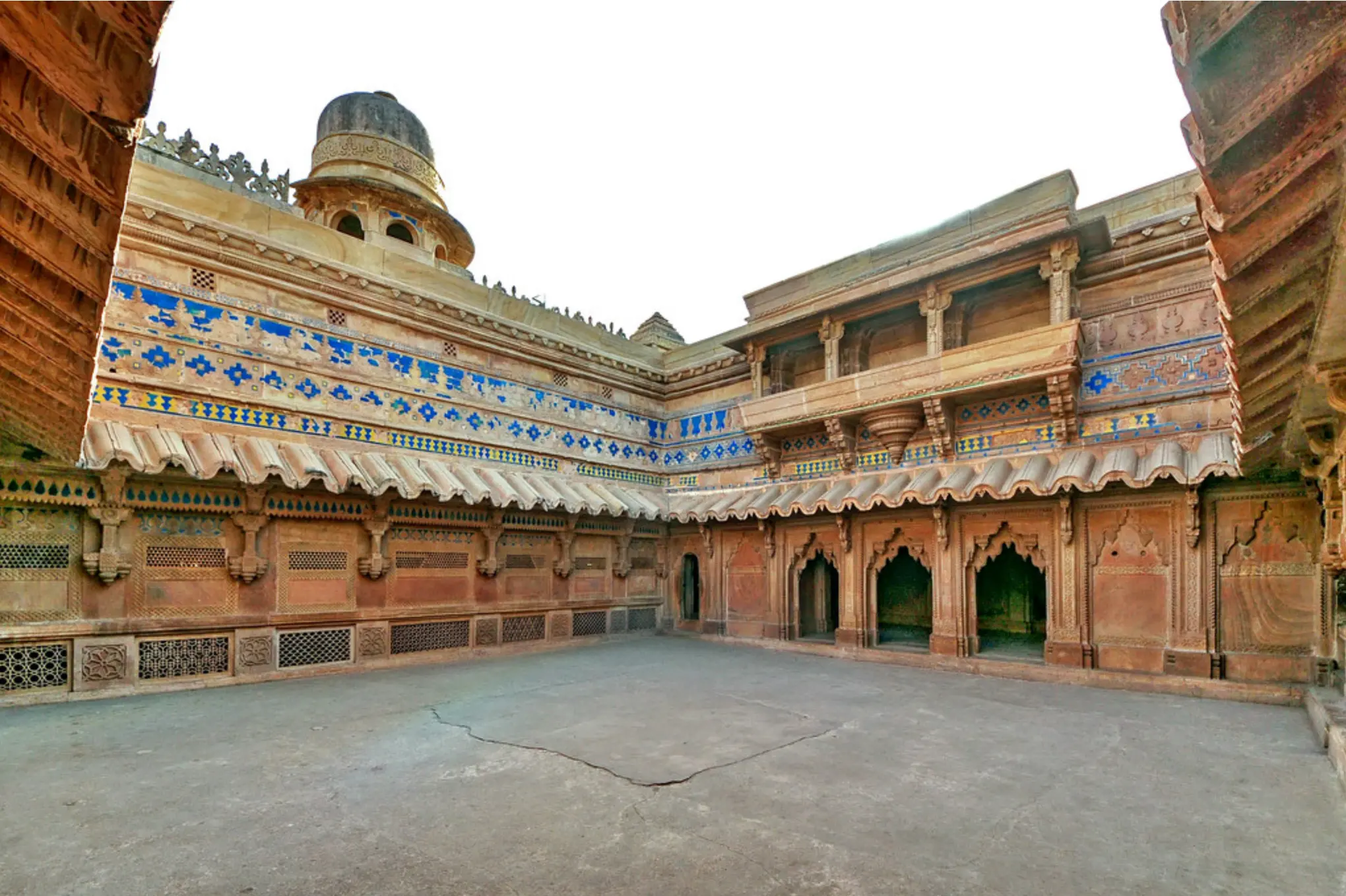
It was constructed in the 15th century by Raja Man Singh Tomar. The palace is four stories high, with two floors underground. The underground parts were once used as prisons when the Mughals took over. The outside of the palace is covered with tiles in shades of blue, green, and yellow. If you look closely, you’ll see carvings of animals like ducks, tigers, and crocodiles, reflecting the king’s love for nature.
Visit Gujari Mahal
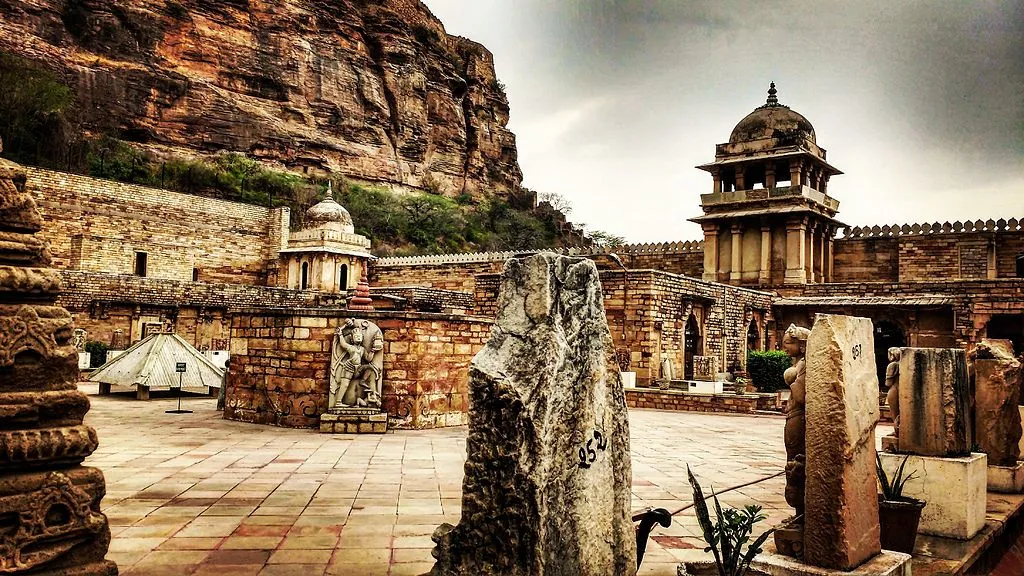
Gujari Mahal was also built by Raja Man Singh, but it was made specifically for his queen, Mrignayani. She was from a humble background and always wanted easy access to water, so the king built this palace near a water tank to fulfill her wish. Gujari Mahal isn’t as ornate as Man Singh Palace, but it’s still beautiful. It’s made of red sandstone, and its design is a mix of Rajput and Mughal styles.
Marvel at the Jain Sculptures
Gwalior Fort houses several stunning Jain rock-cut sculptures that are ranked among the largest in India. The most prominent of these is the 108-foot-tall sculpture of Lord Jain Tirthankar. These ancient carvings speak volumes about the spirituality and cultural depth of the area, enabling the people to appreciate the size and detail of Jain art and architecture.
Explore Teli Ka Mandir
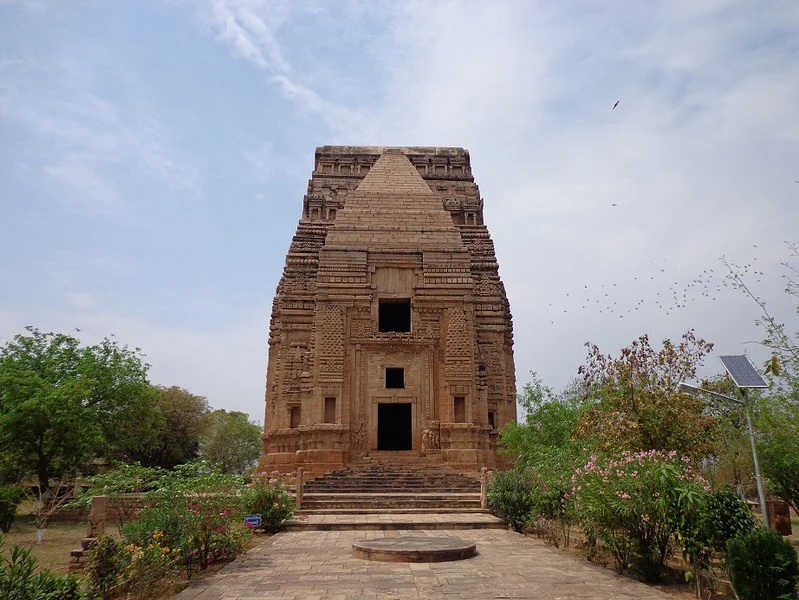
Teli Ka Mandir, constructed in the 9th century, offers an impressive combination of South Indian Dravidian architecture and North Indian Nagara-style architecture. The temple features carvings of elephants, floral patterns, and images of gods and goddesses. The huge entrance is seen to be full of carvings with dancing humans and other religious symbols on it.
Experience the Light and Sound Show
In the evening, don’t miss the light and sound show that narrates the rich history of Gwalior Fort. The show, which takes place within the fort, uses dramatic lighting and sound effects to bring the fort’s past to life, recounting tales of royalty, battles, and the fort’s strategic importance. It’s a captivating way to learn more about the fort’s history in a visually engaging manner.
Places to Visit Near Gwalior Fort
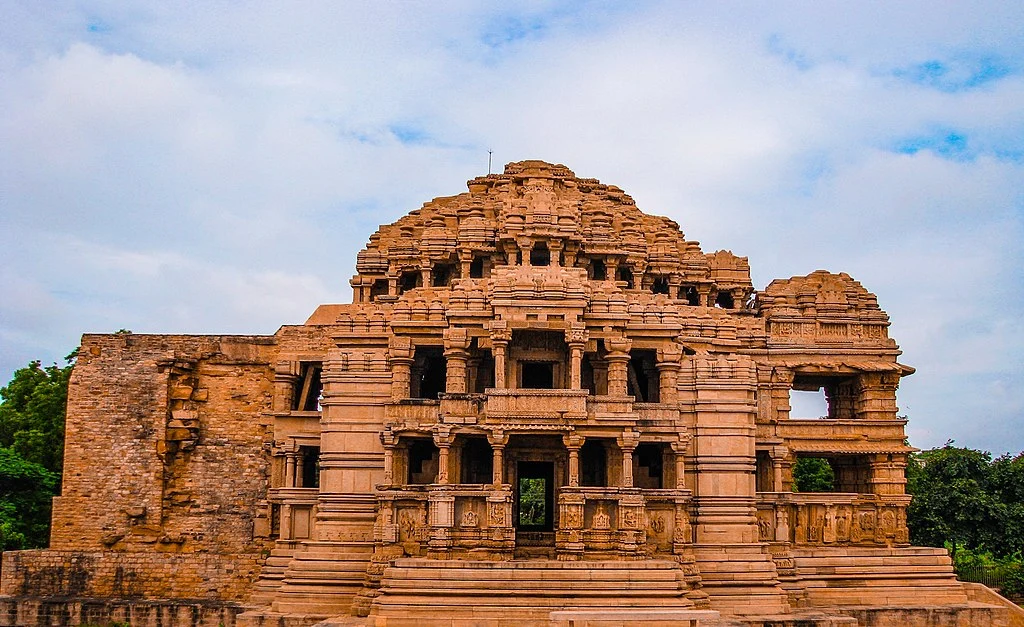
While Gwalior Fort itself is a major attraction, several nearby places will enhance your experience and allow you to explore the rich history and culture of the region. Here are some places to visit near Gwalior Fort:
- Sas Bahu Temples: Despite its name (“Sas Bahu” translates to “Mother-in-law and Daughter-in-law”), this twin temple is dedicated to Lord Vishnu. The temples date back to the 11th century and are magnificently built following the Nagara architectural style. They are skillfully carved and embellished with depictions of various scenes from Hindu epics, such as the Mahabharata and the Ramayana.
- Timings: 07:30 AM – 05:30 PM
- Entry Fee: Free
- Open Days: Every day
- Gwalior Zoo: The Gwalior Zoo, situated close to the Gwalior Fort, is a family-friendly zoo and an animal lovers’ delight. The zoo is filled with different species of animals, birds, and reptiles and also features neat gardens and walking paths. The zoo is merely a 10-minute drive from Gwalior Fort, so you can even visit on the same day.
- Timings: 09:15 AM – 06:30 PM
- Entry Fee: INR 20 for adults, INR 10 for children
- Open Days: Every day
- Tighra Dam: Tighra Dam is located about 20 km from the Gwalior Fort. It is encircled with dense vegetation, providing a calm atmosphere for activities like picnics, boating, and bird-watching. It’s a perfect getaway for people who love being surrounded by nature.
- Timings: 9:00 AM – 5:00 PM
- Entry Fee: None; fees for boating are applicable
- Open Days: Every day
Places to Eat Near Gwalior Fort

Here are three popular restaurants near Gwalior Fort, along with their unique offerings:
- The Indian Coffee House: A nostalgic and iconic spot in Gwalior, known for its old-school charm and retro vibe, the restaurant serves traditional Indian snacks and coffee, offering a cozy, casual dining experience that’s perfect for those looking for a quick bite or a relaxing break.
- Sukh Sagar Restaurant: Famous for its South Indian cuisine, Sukh Sagar offers a wide range of dosas, idlis, and other delicacies. It’s well-loved by locals for its affordable, delicious food and friendly service.
- Silver Saloon: Located inside the luxurious Taj Usha Kiran Palace, this fine dining restaurant offers an elegant ambiance and a menu that combines international and Indian cuisines.
How to Plan a Trip to Gwalior Fort?
If you love history and exploring old places, this fort will surely impress you. Before you go, think about what you want to do or where you’ll stay. There are affordable hotels near the fort and in the city center, ideal for those who need a comfortable place to rest after exploring.
If you want to dive deeper into the fort’s history, you can take a guided tour. The guides can explain all the interesting facts and stories behind the fort’s construction and the kings who lived there.
Gwalior Fort is a photographer’s dream with its historical architecture and stunning views. If you’re into photography or simply want to enjoy the sights, walking around the fort on your own is a great way to experience it.
How to Reach Gwalior Fort
Now that you know how to go about planning your visit, let’s look at how to get to the fort:
- By Train
The Gwalior Railway Station is the closest to the fort, a short, four-kilometer distance that takes only 13 minutes to reach. Gwalior is connected by rail to many cities, including Delhi, Agra, and Mumbai, as most of the trains pass via Gwalior. On arriving at the station, you can take a taxi or auto rickshaw to the fort, or if you prefer a hassle-free ride, you can book a car via the Savaari car rental app for a comfortable journey.
- By Road
Gwalior is well connected by roads to other cities like Delhi (about 320 kilometers) and Agra (about 120 kilometers). You can travel by bus to these cities and then take a taxi or auto-rickshaw to reach the fort in Gwalior. It would be about 6-7 hours from Delhi by road and 2-3 hours from Agra. Book a cab service from Agra with Savaari and travel safely to Gwalior at your own convenience.
- By Flight
Gwalior has a small airport called Gwalior Airport, located about 16 kilometers from the fort. Although not large, the airport does have inbound flights from other cities like Delhi and Mumbai. From there, taxis are readily available, and it will take about 35-40 minutes to reach the fort. But if you are reaching IGI Airport in Delhi, you can book an airport taxi in Delhi Airport with Savaari and travel comfortably in chauffeur-driven cabs to the Fort or any other place in Gwalior.
Things to Do Near Gwalior Airport
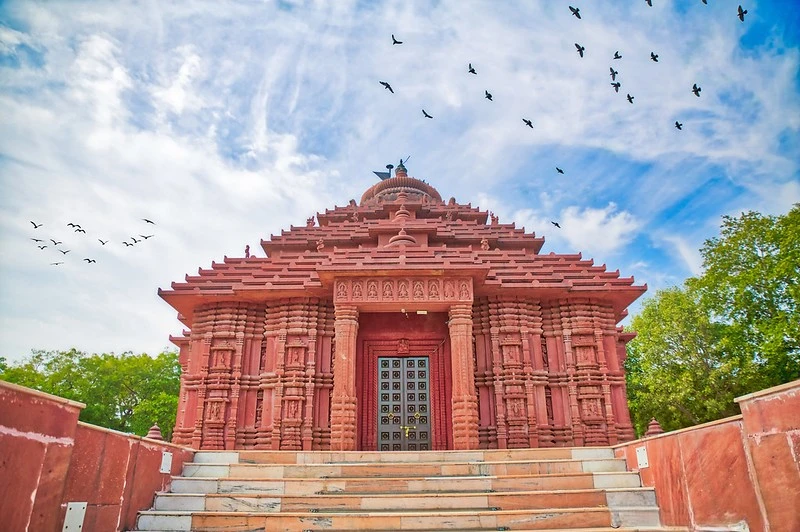
If you have some free time, here are a few other places to check out near Gwalior Airport:
- Tomb of Tansen: Located in Gwalior, this tomb is dedicated to one of the greatest classical musicians in Indian history, Tansen. He was part of Emperor Akbar’s court and is known for his contribution to Indian classical music. The tomb is a peaceful and historic site where you can learn about Tansen’s life and musical legacy.
- Sun Temple Gwalior: The Sun Temple is a beautiful temple dedicated to the Sun God, built in the traditional style of a chariot. It is located on a hill and offers a stunning view of the surrounding area. The temple is especially beautiful during sunrise and sunset, making it a perfect spot for peaceful reflection and photography.
Best Time to Visit Gwalior Fort
The best time to visit Gwalior Fort is between October and March. During this period, the weather is cooler and more comfortable for walking and exploring the fort. Avoid summer, as it can get too hot, and monsoon season because the rain might make the fort hard to access.
Timings and Entry Fees for Gwalior Fort
The Gwalior Fort is open for visitors every day from 7:00 AM to 5:30 PM. To make the most of your visit, it’s a good idea to go either in the morning, soon after the fort opens, or in the late afternoon. This way, you can avoid the heat of the midday sun and enjoy exploring comfortably.
Entry Fees:
- For Indians: INR 75
- For Children (above 15 years of age): INR 40
- For Children (below 15 years of age): Free
- For International Tourists: INR 250
Travel Tips for Visiting Gwalior Fort
To ensure a smooth and enjoyable experience as you explore the fort, here are some essential travel tips to keep in mind:
- Comfortable Shoes: Gwalior Fort requires extensive walking, including on uneven paths, so wear shoes that are comfortable for long walks.
- Stay Hydrated: Bring a water bottle to stay refreshed, especially since the fort can get hot, and there might not be many places to buy water.
- Hire a Guide: A local guide can provide valuable insights into the fort’s history and significance.
- Bring Sun Protection: Make sure to protect yourself from the sun with sunscreen, a hat, and sunglasses.
- Stay Safe: Be cautious of slippery or uneven spots, especially near high points and edges, to avoid accidents.
Hotels and Resorts Near Gwalior Fort
Here is a list of some top resorts and hotels near Gwalior Fort to make your stay and dining experience comfortable.
| Hotel Name | Address | Phone Number |
| Taj Usha Kiran Palace | Lashkar, Gwalior, Madhya Pradesh-474009 | +91 751 244 4000 |
| Hotel Gwalior Regency | New Bus Stand, Link Road Gwalior-474002 | +91 751 234 0670 |
| The Central Park Hotel | Madhav Rao Scindia Marg, Gwalior-474001 | +91 777 300 1690 |
| Deo Bagh Resort | Anand Nagar, Gwalior, Madhya Pradesh-474012 | +91 124 466 6166 |
Highest Road Trips from Gwalior
Once you’ve explored the magnificent Gwalior Fort, why not take a road trip to discover more nearby gems? Here are some fantastic destinations to explore from Gwalior:
| Destination | Distance by Road (approx.) | Time Taken | Price |
| Gwalior to Jhansi | 103 km | 2 hours | INR 3512 |
| Gwalior to Orchha | 123 km | 2.5 hours | INR 3110 |
| Gwalior to Agra | 120 km | 3 hours | INR 3380 |
| Gwalior to Shivpuri | 118 km | 2 hours | INR 3553 |
| Gwalior to Datia | 75 km | 2 hours | INR 3512 |
| Gwalior to Morena | 40 km | 1 hour | INR 1830 |
| Gwalior to Dholpur | 64 km | 1.5 hours | INR 3215 |
Why Visiting Gwalior Fort Should Be on Your Next Travel List
Gwalior Fort is an absolute must on your travel bucket list. As one of the oldest and most awe-inspiring forts in India, just imagine the vast history that has unfolded within its walls! When you visit, you’ll step back in time, uncovering centuries of fascinating tales and hidden secrets, all while marveling at the majestic architecture and breathtaking city views.
Ready to explore? Download the Savaari cab booking app now and start your journey!
Useful Links
Last Updated on January 3, 2025 by Sudarshan Jain
